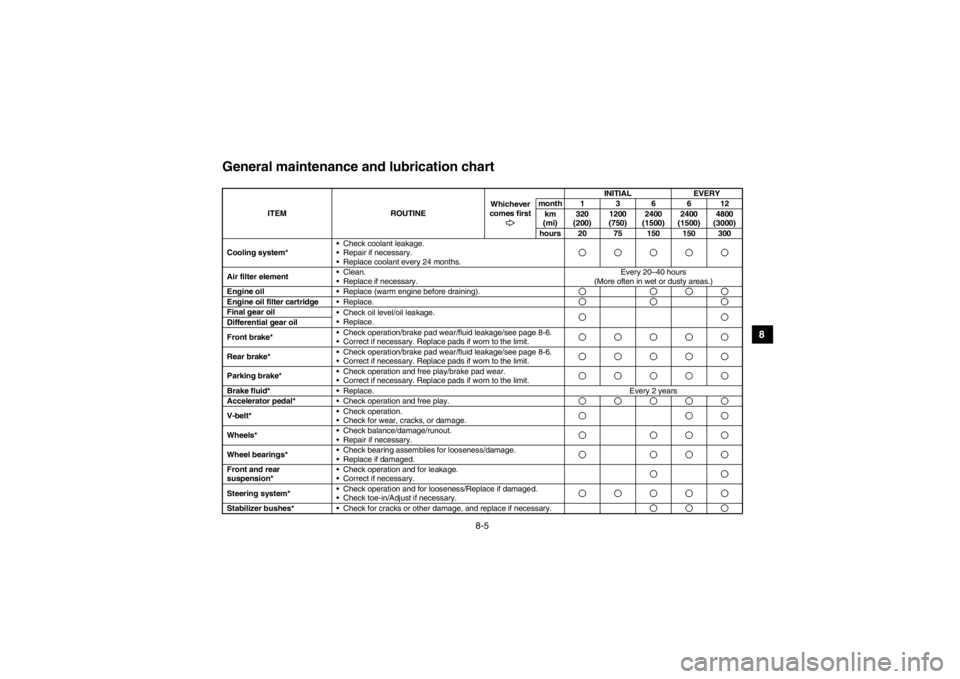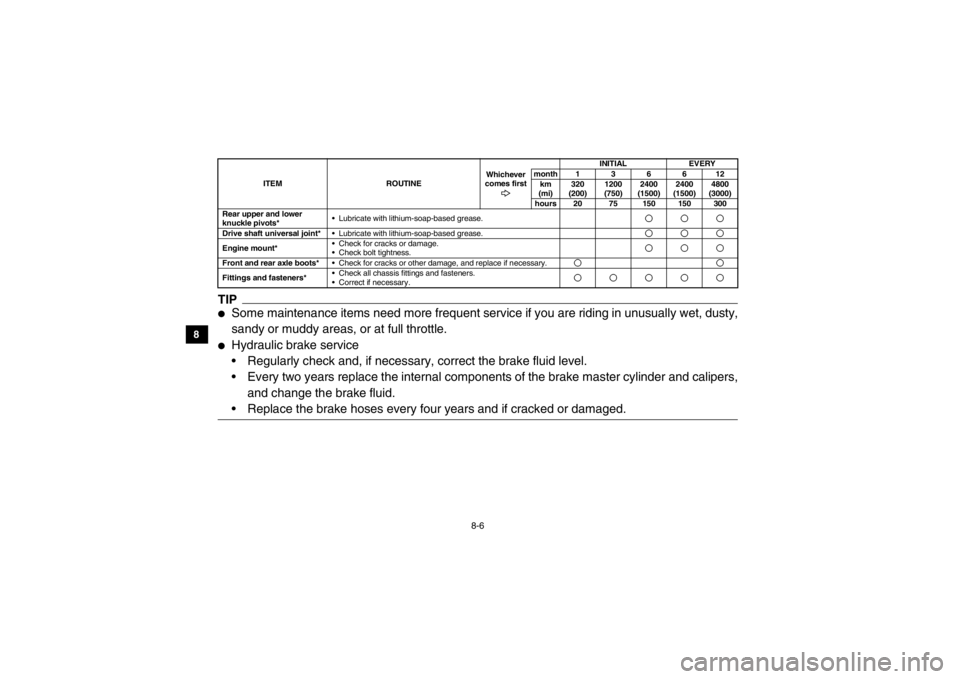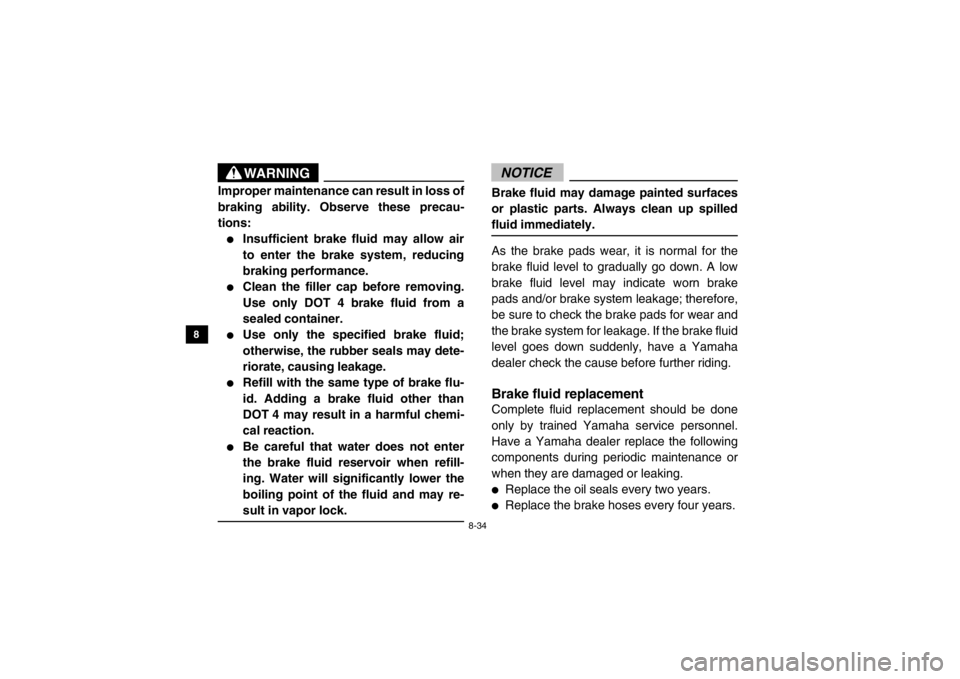Page 110 of 180

7-26
7
8
9
10
11
12
13
14
Brush or wooded areas
When operating in areas with brush or trees,
watch carefully on both sides and above the
vehicle for obstacles such as branches that
the vehicle might hit, causing an accident.
Watch for brush that might enter the vehicle
as you pass and strike you or the passengers.
Never hold onto the cage/frame. The passen-
gers should always hold onto the passenger
handhold with both hands.
The muffler and other engine parts become
extremely hot during operation and remain
hot after the engine has stopped. To reduce
the risk of fire during operation or after leaving
the vehicle, do not let brush, grass and other
materials collect under the vehicle, near the
muffler or exhaust pipe, or next to other hot
parts. Check under the vehicle after operating
in areas where combustible materials may
have collected. Do not idle or park the vehicle
in long dry grass or other dry ground cover. Encountering obstacles
If you cannot go around an obstacle, such as
a fallen tree or a ditch, stop the vehicle where
it is safe to do so. Set the parking brake and
get out to inspect the area thoroughly. Look
from both your approach side and exit side. If
you believe you can continue safely, choose
the path that will allow you to get over the ob-
stacle and at as close to a right angle as pos-
sible to minimize vehicle tipping. Go only fast
enough to maintain your momentum but still
give yourself plenty of time to react to chang-
es in conditions.
If there is any question about your ability to
maneuver safely over the obstacle, you
should turn around if the ground is flat and you
have the room or back up until you find a less
difficult path.1XP7B_EE.book Page 26 Tuesday, February 4, 2014 3:40 PM
Page 111 of 180

8-1
1
2
3
4
5
6
78
9
10
11
12
13
14
EVU006501-PERIODIC MAINTENANCE AND ADJUSTMENTPeriodic inspection, adjustment, and lubrica-
tion will keep your vehicle in the safest and
most efficient condition possible.
Safety is an obligation of the vehicle owner/
operator. The most important points of vehicle
inspection, adjustment, and lubrication are ex-
plained on the following pages.
WARNING
Failure to properly maintain the vehicle or
performing maintenance activities incor-
rectly may increase your risk of injury or
death during service or while using the ve-
hicle. If you are not familiar with vehicle
service, have a Yamaha dealer perform
service.
WARNING
Turn off the engine when performing main-
tenance unless otherwise specified.●
A running engine has moving parts
that can catch on body parts or cloth-
ing and electrical parts that can cause
shocks or fires.
●
Running the engine while servicing
can lead to eye injury, burns, fire, or
carbon monoxide poisoning – possi-
bly leading to death. See page 2-7 for
more information about carbon mon-
oxide.WARNING
Brake discs, calipers, drums, and linings
can become very hot during use. To avoid
possible burns, let brake components cool
before touching them.
1XP7B_EE.book Page 1 Tuesday, February 4, 2014 3:40 PM
Page 115 of 180

8-5
1
2
3
4
5
6
78
9
10
11
12
13
14
EVU01650General maintenance and lubrication chart
ITEM ROUTINEWhichever
comes first INITIAL
EVERY
month136612 km
(mi) 320
(200) 1200
(750) 2400
(1500) 2400
(1500) 4800
(3000)
hours 20 75 150 150 300
Cooling system* Check coolant leakage.
Repair if necessary.
Replace coolant every 24 months.
Air filter element
Clean.
Replace if necessary. Every 20–40 hours
(More often in wet or dusty areas.)
Engine oil Replace (warm engine before draining).Engine oil filter cartridge Replace.Final gear oil
Check oil level/oil leakage.
Replace.Differential gear oil
Front brake* Check operation/brake pad wear/fluid leakage/see page 8-6.
Correct if necessary. Replace pads if worn to the limit.Rear brake* Check operation/brake pad wear/fluid leakage/see page 8-6.
Correct if necessary. Replace pads if worn to the limit.Parking brake*
Check operation and free play/brake pad wear.
Correct if necessary. Replace pads if worn to the limit.Brake fluid*
Replace. Every 2 years
Accelerator pedal* Check operation and free play.V-belt* Check operation.
Check for wear, cracks, or damage.Wheels* Check balance/damage/runout.
Repair if necessary.Wheel bearings*
Check bearing assemblies for looseness/damage.
Replace if damaged.Front and rear
suspension* Check operation and for leakage.
Correct if necessary.Steering system*
Check operation and for looseness/Replace if damaged.
Check toe-in/Adjust if necessary.Stabilizer bushes*
Check for cracks or other damage, and replace if necessary.
1XP7B_EE.book Page 5 Tuesday, February 4, 2014 4:19 PM
Page 116 of 180

8-6
8
9
10
11
12
13
14
TIP●
Some maintenance items need more frequent service if you are riding in unusually wet, dusty,
sandy or muddy areas, or at full throttle.
●
Hydraulic brake service
Regularly check and, if necessary, correct the brake fluid level.
Every two years replace the internal components of the brake master cylinder and calipers, and change the brake fluid.
Replace the brake hoses every four years and if cracked or damaged.Rear upper and lower
knuckle pivots* Lubricate with lithium-soap-based grease.Drive shaft universal joint*
Lubricate with lithium-soap-based grease.Engine mount* Check for cracks or damage.
Check bolt tightness.Front and rear axle boots*
Check for cracks or other damage, and replace if necessary.Fittings and fasteners* Check all chassis fittings and fasteners.
Correct if necessary.
ITEM
ROUTINEWhichever
comes first INITIAL
EVERY
month136612 km
(mi) 320
(200) 1200
(750) 2400
(1500) 2400
(1500) 4800
(3000)
hours 20 75 150 150 300
1XP7B_EE.book Page 6 Tuesday, February 4, 2014 4:19 PM
Page 142 of 180
8-32
8
9
10
11
12
13
14
BrakesReplacement of brake components requires
professional knowledge. Brake service should
be performed by a Yamaha dealer.
WARNING
Operating with improperly serviced or ad-
justed brakes could lead to a loss in brak-
ing ability and an accident.5B410019Checking the front and rear brake padsEach brake pad is provided with wear indica-
tor grooves, which allow you to check the
brake pad wear without having to disassem-
ble the brake. To check the brake pad wear,
check the wear indicator grooves. If a brake
pad has worn to the point that the wear indica-
tor grooves have almost disappeared, have a
Yamaha dealer replace the brake pads as a
set. The wheels need to be removed to check the
brake pads. (See pages 8-39, 8-41 for wheel
removal and installation procedures.)
1. Brake pad wear indicator groove
1
1XP7B_EE.book Page 32 Tuesday, February 4, 2014 3:40 PM
Page 143 of 180
8-33
1
2
3
4
5
6
78
9
10
11
12
13
14
5B410020Checking the parking brake padsEach brake pad is provided with a wear indi-
cator groove, which allows you to check the
brake pad wear without having to disassem-
ble the brake. If a brake pad has worn to the
point that the wear indicator groove has al-
most disappeared, have a Yamaha dealer re-
place the brake pads as a set.1. Brake pad wear indicator groove
EVU00850Checking the brake fluid levelBefore riding, check that the brake fluid is
above the minimum level mark. Check the
brake fluid level with the top of the reservoir
level. Replenish the brake fluid if necessary.1. Minimum level mark
1
Specified brake fluid: DOT 4
1
1XP7B_EE.book Page 33 Tuesday, February 4, 2014 3:40 PM
Page 144 of 180

8-34
8
9
10
11
12
13
14
WARNING
Improper maintenance can result in loss of
braking ability. Observe these precau-
tions:●
Insufficient brake fluid may allow air
to enter the brake system, reducing
braking performance.
●
Clean the filler cap before removing.
Use only DOT 4 brake fluid from a
sealed container.
●
Use only the specified brake fluid;
otherwise, the rubber seals may dete-
riorate, causing leakage.
●
Refill with the same type of brake flu-
id. Adding a brake fluid other than
DOT 4 may result in a harmful chemi-
cal reaction.
●
Be careful that water does not enter
the brake fluid reservoir when refill-
ing. Water will significantly lower the
boiling point of the fluid and may re-
sult in vapor lock.
NOTICEBrake fluid may damage painted surfaces
or plastic parts. Always clean up spilled
fluid immediately.As the brake pads wear, it is normal for the
brake fluid level to gradually go down. A low
brake fluid level may indicate worn brake
pads and/or brake system leakage; therefore,
be sure to check the brake pads for wear and
the brake system for leakage. If the brake fluid
level goes down suddenly, have a Yamaha
dealer check the cause before further riding.EVU00860Brake fluid replacementComplete fluid replacement should be done
only by trained Yamaha service personnel.
Have a Yamaha dealer replace the following
components during periodic maintenance or
when they are damaged or leaking.●
Replace the oil seals every two years.
●
Replace the brake hoses every four years.
1XP7B_EE.book Page 34 Tuesday, February 4, 2014 3:40 PM
Page 145 of 180
8-35
1
2
3
4
5
6
78
9
10
11
12
13
14
EVU01220Checking the brake pedalHave a Yamaha dealer check the brakes at
the intervals specified in the periodic mainte-
nance and lubrication chart. There should be
no free play in the brake pedal. The brakes
should operate smoothly and there should be
no brake drag. If the brakes feel soft or
spongy, this could indicate air in the brake
system. Have a Yamaha dealer check the
brake system if necessary.1. Brake pedal a. No brake pedal free play
EVU00870Parking brake lever free play
adjustmentPeriodically check the parking brake lever free
play and adjust it if necessary.
1. Shift the drive select lever into low gear “L”.
2. Check the parking brake lever free play. The maximum free play is equal to one
click of the parking brake lever. If neces-
sary, adjust the free play as follows.a. Parking brake lever free play
1
a
a
1XP7B_EE.book Page 35 Tuesday, February 4, 2014 3:40 PM